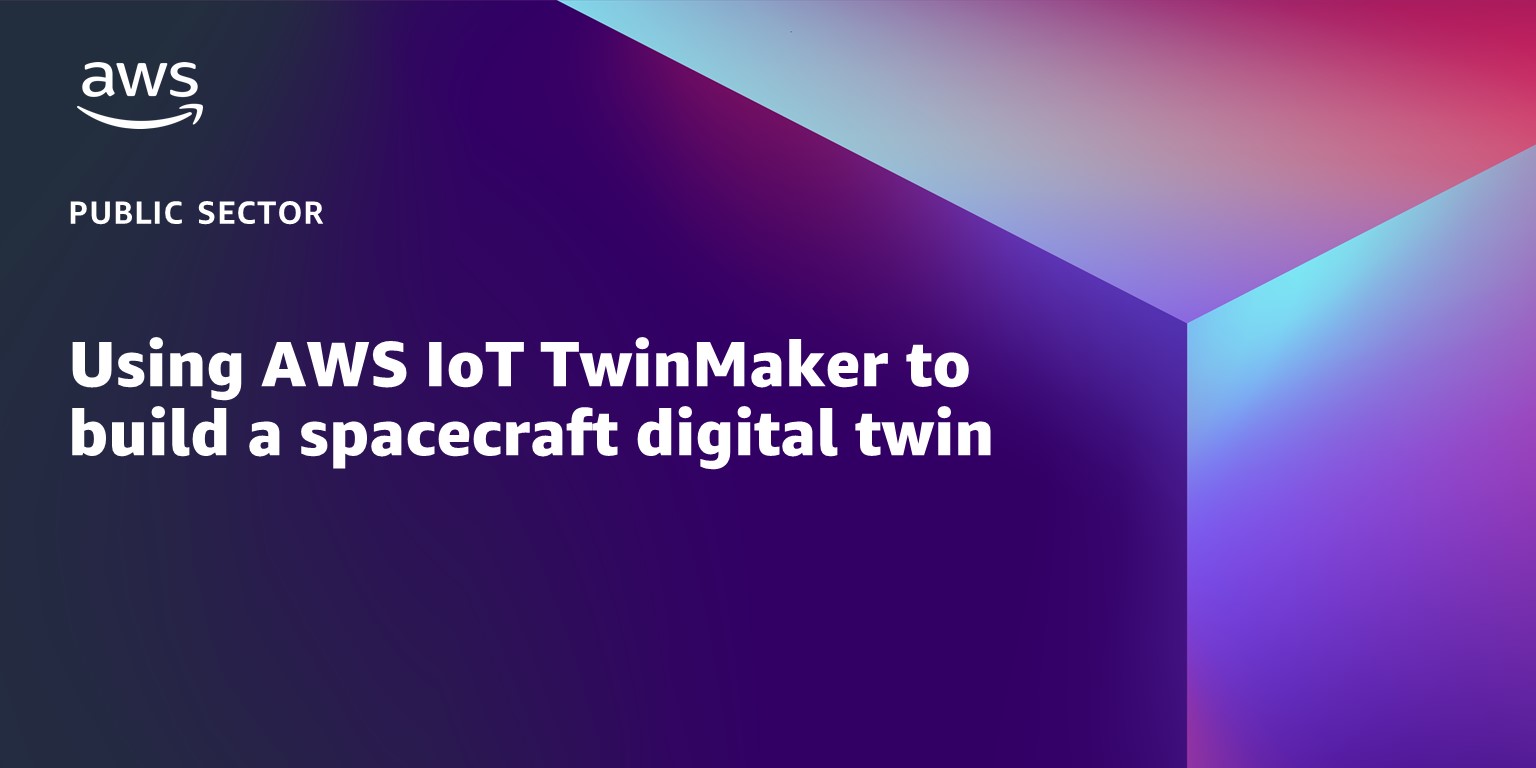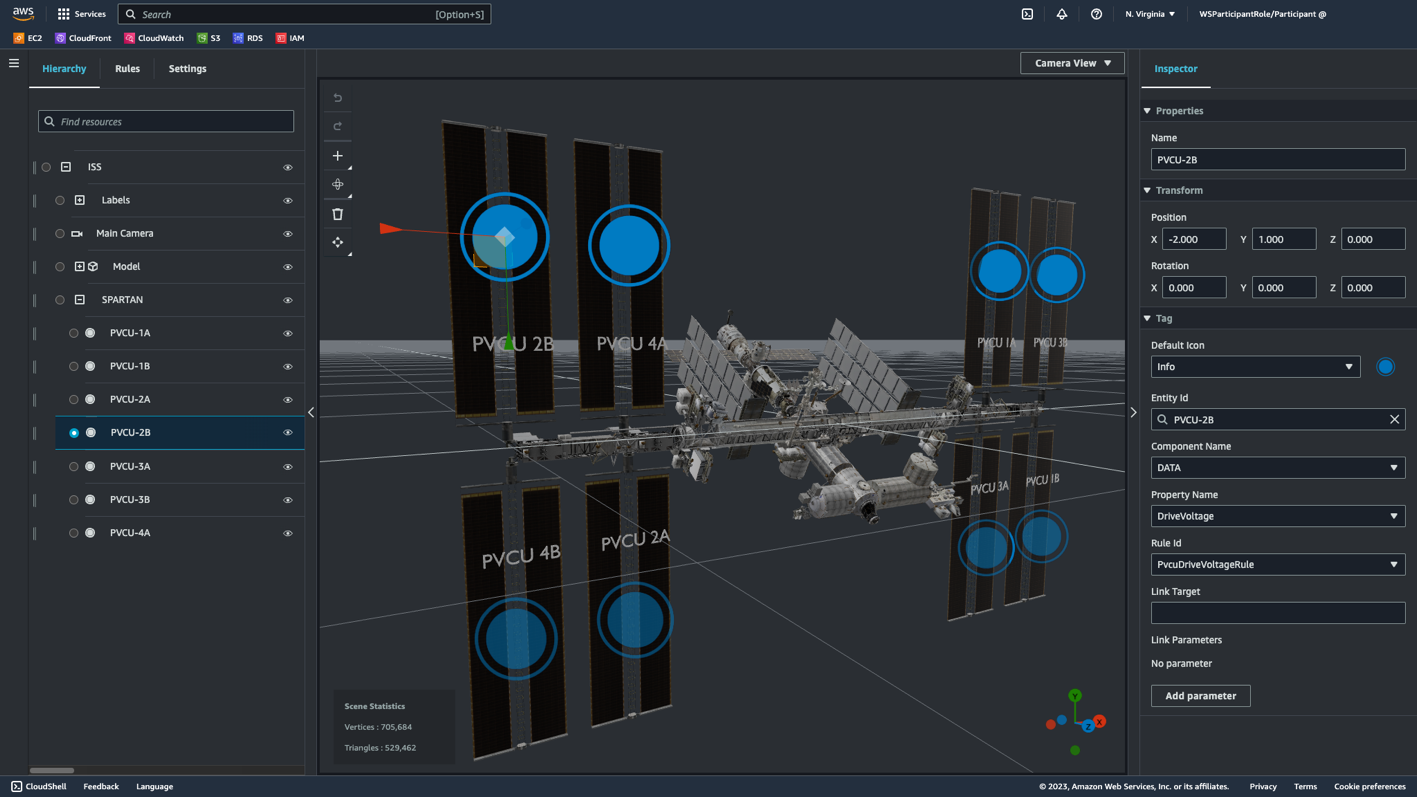AWS Public Sector Blog
Using AWS IoT TwinMaker to build a spacecraft digital twin
Digital twin technology helps drive the digital transformation of the space sector by optimizing complex spacecraft design, engineering, and operation. Increasingly, customers turn to AWS IoT TwinMaker from Amazon Web Services (AWS) to more quickly and simply create simulations that provide live actionable insights and improve operational performance of real-life systems.
AWS IoT TwinMaker helps customers leverage disparate data sources to more simply build and utilize digital twins of any physical environment, whether on Earth or in Space. Now available in the AWS GovCloud (US-West) Region, AWS IoT TwinMaker-powered solutions can comply with regulations such as International Traffic in Arms Regulations (ITAR) and the Federal Risk and Authorization Management Program (FedRAMP) High baseline.
In this blog post, learn how you can use AWS to create digital twin simulations for complex spacecraft, demonstrated using the International Space Station (ISS) via publicly available telemetry from the National Aeronautics and Space Administration (NASA).
What is a digital twin?

Figure 1. ISS digital twin.
A digital twin is a virtual representation of a physical object that simulates the object’s behavior and monitors operations throughout the object’s lifecycle, using real-time data sent from the object.
Previously, digital twins were challenging to implement due to several factors, such as difficulties performing advanced spatial computing in a cost-effective manner and the inability to scale compute resources elastically to support the computationally intense simulations that digital twins require.
Advances across multiple technologies – including cloud computing – now make it simpler to use digital twin simulation. The modeling methods and capabilities needed, such as machine learning and computational fluid dynamics, have greatly improved and become much more readily available, facilitating the creation of future state predictions and immersive environments. AWS Cloud computing advances have reduced the hardware and human resources needed to scale computing capabilities appropriately and within budget to make digital twin simulation more accessible.
Building a digital twin with AWS IoT TwinMaker
Let’s explore the five key components of creating an AWS IoT TwinMaker digital twin. First, you create a workspace, which is a high-level container for the other resources. Next, you can create a physical model of your object. Once the model is created, you connect data flows from your data sources—such as with AWS IoT SiteWise, a managed service that simplifies collecting, organizing, and analyzing industrial equipment data—to that object. Then, you can create visualizations based on that data to simulate the behavior of your object. Finally, you can configure user access to the model. Read the AWS IoT TwinMaker documentation to dive deeper into these steps.
Figure 2. With AWS IoT TwinMaker, you connect data, model your physical object, compose a 3D model, and then can monitor and improve industrial operations with predictive maintenance, remote modeling, and more.
The AWS IoT TwinMaker workspace provides a scene composition tool for creating scenes in 3D. You can import previously created 3D/CAD models optimized for web display and converted to .gltf or .glb format. Then, you can use the scene composer feature to place multiple models in a single scene to create visual representations of their operations. Next, you can place data overlays to represent state and visualize operating conditions.
Figure 3. External ISS digital twin in AWS IoT TwinMaker Scene Composer.
To create a virtual representation of the ISS within scene composer, you can import a 3D model of the ISS into AWS IoT TwinMaker. For anyone interested in duplicating this digital twin, this walkthrough utilizes 3D models provided for public consumption by NASA. To follow along, download the ISS 3D model in .glb format, add the .glb file to your workspace resource library, and then import it into your scene.
Figure 4. Internal ISS digital twin in AWS IoT TwinMaker Scene Composer.
Entities are digital representations of components used within AWS IoT TwinMaker to capture system capabilities and operational states. They can be a subsystem, a concept, or a process. These components provide data and context for the associated entity. With AWS IoT TwinMaker and AWS IoT SiteWise, you can organize entities and components into a hierarchy to model the live twin.
Figure 5 illustrates a generic entity diagram depicting systems and subsystems of a typical spacecraft.
Figure 5. Possible entity diagram of a spacecraft.
Collecting and storing the data with AWS IoT SiteWise
Next, you can feed the virtual representation with live actionable information flowing out from the ISS. In this walkthrough, we connect real-time metrics made publicly available from NASA’s LightStreamer (available on GitHub) to a web socket, that you can create using your preferred language, such as Go, listening within an Amazon Elastic Compute Cloud (Amazon EC2) instance. Then, we insert that data into AWS IoT SiteWise as a data source for the ISS digital twin using the AWS IoT SiteWise API’s BatchPutAssetPropertyValue operation.
Once sensor data is flowing into AWS IoT SiteWise data streams, you must create data models of edge devices and systems within AWS IoT SiteWise to structure and organize it into asset measurements. Next, you must link the data ingested into AWS IoT SiteWise to the asset models created and instantiate the models that represent the actual edge devices and equipment. AWS IoT TwinMaker can automatically discover and visualize data from assets that have already been ingested and modeled with AWS IoT SiteWise.
Visualizing the data
Finally, to fully utilize a digital twin’s capabilities, you can create web-based digital twin applications using the AWS IoT TwinMaker plug-in for Amazon Managed Grafana with dashboards that embed the 3D scenes and display data and insights about the operational state of your physical systems from the digital twin. These applications use the AWS IoT TwinMaker unified data access APIs to populate the data in the dashboards.
Figure 6 features a digital twin dashboard of the ISS that can be created using Grafana. This example shows live metrics from the ISS such as the current internal cabin temperature; current cabin pressure; airlock status; live video streaming from an external camera; and one of the solar array panel’s voltage, current, and position.
Figure 6. Dashboard visualization of ISS digital twin using Amazon Managed Grafana.
Aerospace customers can benefit from using AWS IoT TwinMaker in many ways. Digital twins can provide a better understanding of life expectancy for aerospace systems, which saves costs, improves supply chain management, improves operations, and improves performance. Also, digital twins can supplement or entirely replace the physical prototypes historically required for simulations. The creation of digital representations versus physically creating a prototype system for testing can save customers time and money.
Learn how AWS customers use AWS IoT TwinMaker to support rapid development, increase sustainability efforts, and more. To get started, log in to the AWS Management Console and navigate to AWS IoT TwinMaker. To learn more, refer to the AWS IoT TwinMaker documentation. To explore service capabilities and sample digital twin applications, visit the AWS IoT TwinMaker GitHub repository.
Learn more about AWS for aerospace and satellite
Organizations of all sizes across all industries are transforming and delivering on their aerospace and satellite missions every day using AWS. Learn more about the cloud for aerospace and satellite solutions so you can start your own AWS Cloud journey today.
Get inspired. Watch our AWS in Space story.
Read more about AWS for aerospace and satellite:
- Amazon and AWS to reimagine space station operations and logistics for Orbital Reef
- How Satellogic and AWS are harnessing the power of space and cloud
- Managing the world’s natural resources with earth observation
- AWS joins the Digital IF Interoperability (DIFI) Consortium
- How Natural Resources Canada migrated petabytes of geospatial data to the cloud
Subscribe to the AWS Public Sector Blog newsletter to get the latest in AWS tools, solutions, and innovations from the public sector delivered to your inbox, or contact us.
Please take a few minutes to share insights regarding your experience with the AWS Public Sector Blog in this survey, and we’ll use feedback from the survey to create more content aligned with the preferences of our readers.





